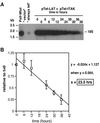The 2-kilobase intron of the herpes simplex virus type 1 latency-associated transcript has a half-life of approximately 24 hours in SY5Y and COS-1 cells
- PMID: 11752144
- PMCID: PMC136830
- DOI: 10.1128/jvi.76.2.532-540.2002
The 2-kilobase intron of the herpes simplex virus type 1 latency-associated transcript has a half-life of approximately 24 hours in SY5Y and COS-1 cells
Abstract
The herpes simplex virus type 1 (HSV-1) 2-kb latency-associated transcript (LAT) is a stable intron, which accumulates in cells both lytically and latently infected with HSV-1. We have used a tetracycline-repressible expression system to determine the half-life of the 2-kb LAT RNA intron in the human neuroblastoma cell line SY5Y. Using Northern hybridization analyses of RNA isolated from transiently transfected SY5Y cells over time after repression of LAT expression, we measured the half-life of the 2-kb LAT to be approximately 24 h. Thus, unlike typical introns that are rapidly degraded in a matter of seconds following excision, the 2-kb LAT intron has a half-life similar to those of some of the more stable cellular mRNAs. Furthermore, a similar half-life was measured for the 2-kb LAT in transiently transfected nonneuronal monkey COS-1 cells, suggesting that the stability of the 2-kb LAT is neither cell type nor species specific. Previously, we found that the determinant responsible for the unusual stability of the 2-kb LAT maps to the 3' terminus of the intron. At this site is a nonconsensus intron branch point located adjacent to a predicted stem-loop structure that is hypothesized to prevent debranching by cellular enzymes. Here we show that mutations which alter the predicted stem-loop structure, such that branching is redirected, either reduce or abolish the stability of the 2-kb LAT intron.
Figures






Similar articles
-
The half-life of the HSV-1 1.5-kb LAT intron is similar to the half-life of the 2.0-kb LAT intron.J Neurovirol. 2013 Feb;19(1):102-8. doi: 10.1007/s13365-012-0146-6. Epub 2013 Jan 19. J Neurovirol. 2013. PMID: 23335177 Free PMC article.
-
The herpes simplex virus type 1 2.0-kilobase latency-associated transcript is a stable intron which branches at a guanosine.J Virol. 1997 Jun;71(6):4199-208. doi: 10.1128/JVI.71.6.4199-4208.1997. J Virol. 1997. PMID: 9151806 Free PMC article.
-
Regions of the herpes simplex virus type 1 latency-associated transcript that protect cells from apoptosis in vitro and protect neuronal cells in vivo.J Virol. 2002 Jan;76(2):717-29. doi: 10.1128/jvi.76.2.717-729.2002. J Virol. 2002. PMID: 11752162 Free PMC article.
-
Herpes simplex virus latency-associated transcript gene function.J Neurovirol. 2003 Jun;9(3):285-90. doi: 10.1080/13550280390200994. J Neurovirol. 2003. PMID: 12775412 Review.
-
The latency associated transcripts (LAT) of herpes simplex virus: still no end in sight.J Neurovirol. 1997 Oct;3(5):313-21. doi: 10.3109/13550289709030745. J Neurovirol. 1997. PMID: 9372452 Review.
Cited by
-
The half-life of the HSV-1 1.5-kb LAT intron is similar to the half-life of the 2.0-kb LAT intron.J Neurovirol. 2013 Feb;19(1):102-8. doi: 10.1007/s13365-012-0146-6. Epub 2013 Jan 19. J Neurovirol. 2013. PMID: 23335177 Free PMC article.
-
In Vivo Knockdown of the Herpes Simplex Virus 1 Latency-Associated Transcript Reduces Reactivation from Latency.J Virol. 2018 Jul 31;92(16):e00812-18. doi: 10.1128/JVI.00812-18. Print 2018 Aug 15. J Virol. 2018. PMID: 29875240 Free PMC article.
-
The herpes simplex virus type 1 locus that encodes the latency-associated transcript enhances the frequency of encephalitis in male BALB/c mice.J Virol. 2005 Nov;79(22):14465-9. doi: 10.1128/JVI.79.22.14465-14469.2005. J Virol. 2005. PMID: 16254383 Free PMC article.
-
Differentiated Human SH-SY5Y Cells Provide a Reductionist Model of Herpes Simplex Virus 1 Neurotropism.J Virol. 2017 Nov 14;91(23):e00958-17. doi: 10.1128/JVI.00958-17. Print 2017 Dec 1. J Virol. 2017. PMID: 28956768 Free PMC article.
-
Transgenic mouse with the herpes simplex virus type 1 latency-associated gene: expression and function of the transgene.J Virol. 2003 Dec;77(23):12421-9. doi: 10.1128/jvi.77.23.12421-12429.2003. J Virol. 2003. PMID: 14610166 Free PMC article.
References
Publication types
MeSH terms
Substances
Grants and funding
LinkOut - more resources
Full Text Sources
Other Literature Sources
Research Materials

